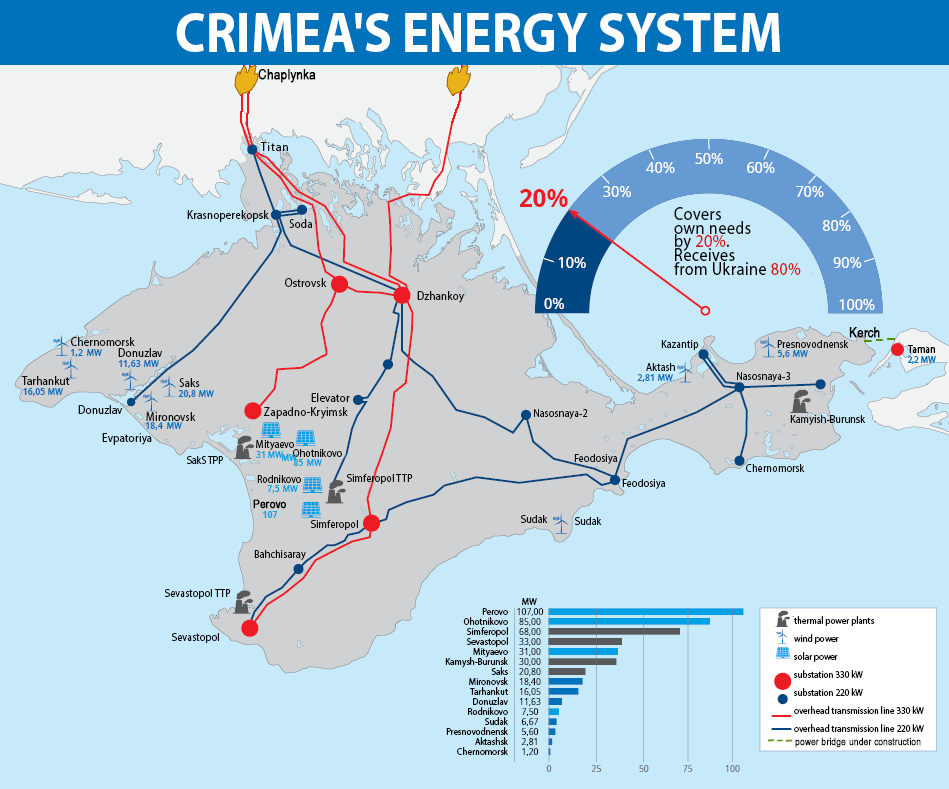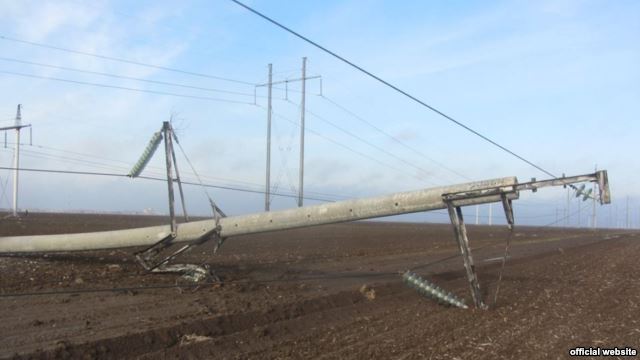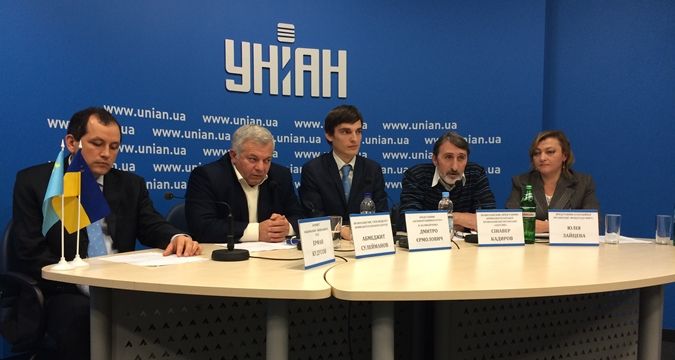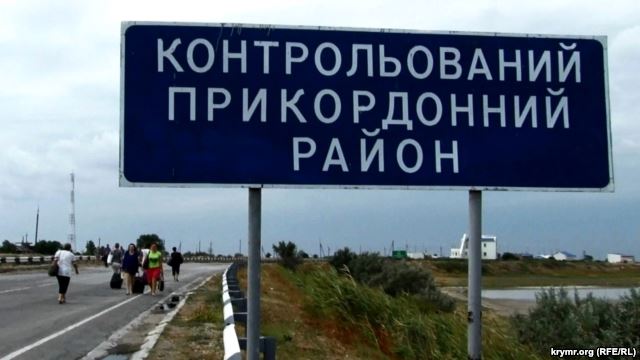Power lines blasts in Ukraine resulted in a blackout in Crimean peninsula which is into its sixth day. While Ukrainian society and media are discussing whether it is worth applying such measures as an energy blockade towards Crimea, Russia is working on building a facade that very soon the peninsula will be able to exist without Ukrainian power. So which mountains of gold have been already promised and is it really so easy to present them?
The last events around Crime have shown that the the energy blockade of the peninsula is far from over. On Thursday, 26 November, employees of the Ukrainian state energy company Ukrenergo stopped works on repairing one of the destroyed power pillars in Kherson Oblast. According to the head of Ukrenergo Information Policy Department Zinovy Butso, this happened “on the demand of the energy blockade participants.”
The day before, Mustafa Dzhemilev, Ukrainian MP and leader of Crimea Tatars, stated that the activists of the energy blockade are not going to restore electricity supply to the peninsula yet. Also Dzhemilev pointed out that the main condition under which energy supply can be renewed is freedom for the Ukrainian political prisoners in Crimea.
“They have to make some moves towards us. I believe that first they must release Akhtem Chiygoz, other significant figures. But they do nothing of it. Now that we have this pressure from society, why the hell should we turn them the light back on,” said Dzhemilev.
1. How much Crimea needs
According to the State Unitary Enterprise of the Republic of Crimea Krymenergo, until recent days Ukraine supplied the peninsula with 1,210 MW. The average power consumption in Crimea amounted to 1,100 MW. This means that Ukraine has even been backing up the occupied peninsula.
Ukrenergo’s temporary acting director, Vsevolod Kovalchuk, told journalists that Crimea can provide itself with 30% of needed electricity:
“Crimea partly has its own generation, it meets 30% of the demand. During the day, if there is good weather, a large portion can be produced by solar power plants, which were built previously.”
However, the Russian website peretok.ru, which focuses on power engineering in Russia and the world, has measured the amount of Crimea’s energy self-reliance at 20% (the below infographic is an English translation of the infographic at peretok.ru, which we have expanded to include the pylons damaged at Chaplynka on 22 November and to the east of Chaplynka two days earlier, and the power bridge under construction at Kerch):

2. What Russia promised
Three days after the beginning of the blackout Russian President Vladimir Putin finally reacted saying that by December 20 the first line of energy bridge from Russia to Crimea will be constructed and in the summer of 2016 the second line will be built.
Russia has been espousing the idea of an energy bridge since the beginning of Crimea’s occupation in March 2014. However, tracking the real steps towards its construction proves to be difficult.
According to The Center of Investigative Journalism which has been following the statements of Russians authorities on the topic, in May 2015 Russian Deputy Minister of Energy said that by the end of this year a 300 MW capacity line will be laid, and in general Russia will provide electrical power generation of about 850 MW. In June 2015, the Russian Minister for Crimea Oleg Savelyev has said that there is no cable for the project. Later the so-called head of Crimea Sergey Aksyonov told that the cable will be optimized for 200MW, not 300. Kerch outlets reported that construction works on the bridge have begun, and that there are plans to construct four lines with a total capacity of 1,7 GW, which is significantly more than it is needed.
A 13 bn ruble tender was conducted for the construction of the cable transition through the Kerch Strait. Neither of the four lines were mentioned there. The contract includes the construction of a line of 220 kW. So probably this construction work is one of the cases of dividing money that will never be shown on public.
3. Crimea’s internal production

In June 2014, the center of Investigative Journalism found that the mobile gas-turbine power plants (MGTPP), which were being put into use in Crimea that time, were not able to cover even a third of the electricity needs of the peninsula. The MGTPP’s were initially created to smooth out peak loads on Moscow’s electrical grid. They were also utilized during the Sochi Olympic Games. But they can’t be a primary energy source, as recognized by Savelyev himself. Energy production turns out to be way too expensive. Nevertheless, MGTPP’s were deployed to Crimea and in total have cost more than 6 bn rubles. Still, they need to be supplied with Ukrainian energy to function.
Wind and solar plants exist (including the largest solar station in Europe in Perovo with a production capacity of 107 MW), but in total they add up to roughly 307 MW at the best days.
4. Legal issues
There need not be additional mentions that Russian actions towards Crimea have been illegal. But some international companies support Russia’s violation of international law. In October 11, 2015 the China’s cable laying vessel JIAN JI 3001 arrived to one of the occupied ports of Kerch.
After the occupation and annexation of Crimea, this port had been expropriated by the so-called government of Crimea, and then all the ports of Kerch were merged into one company, which is included in the EU sanctions lists, as well as the recently updated US Treasury sanctions list. So the owner of the company is not only violated the sanctions of Ukraine, EU and the others. Now it is followed also by The Office of Foreign Assets Control of the US.
In the morning of November 22 , after a long delay the ship JIANGONG 1 moved to resume construction of the power bridge. Its navigation equipment was turned on almost immediately mainland Ukraine stopped supplying electricity. The last official report on the work of laying the cable along the bottom of the Kerch Strait is dated by October 18.
According to BlackSeaNews, the owner and operator of the vessel is The Shanghai Foundation Engineering Group Co, Ltd which specializes in the construction of bridges, tunnels, railways and is a part of the construction company Shanghai Construction Group.
The prosecutors office of the Republic of Crimea (Ukraine) initiated proceedings against the Chinese company.
Previously, Russian outlets reported that the German multinational technology giant Siemens entered into a contract to supply modern gas turbine-powered electricity generating plants for Sevastopol and Simferopol in Crimea in violation of Western sanctions. However, Siemens refuted the information and there had been no confirmation of the delivery.
The possibility that Russia can provide all needed energy to Crimea exists at some theoretical level. All ways of doing it are enormously expensive and need many preparations. Knowing the style of doing business in Russia it is easy to predict that even if money for Crimean energy is allocated, a significant part of it will dive into the deep pockets of corrupted structures.
Why didn’t Russia find an energy solution over 20 months of annexation?
According to the Swiss outlet nzz.ch, Russia wasn’t able to begin construction of needed power generators after annexing Crimea because it would be more expensive to equip Crimea with Russian-produced generators have a smaller capacity than with those produced abroad, which are prohibited by sanctions. Apparently, the Russian leadership was either searching for ways to circumvent sanctions, or waiting for them to be dropped, pursuing a cost-effective solution.
Also, it needs to be mentioned that Krasnodar Krai, the nearest Russian region to Crimea, experiences a power shortage itself. According to Russian media, the deficit was 2 GW and to cover it Russia will need 45 bn rubles. In general, Krasnodar Krai has 650 feeding centers, of which 400 are closed, meaning it is impossible to connect to them. So it seems that the Russian conversations about Crimea’s energy independence is to the large extent is a media campaign focused on building the image of a great and all-powerful Federation.
Crimea is also dependent on Ukrainian food and water
As a subsidized region, Crimea also needs water. “The amount of water that exists on the peninsula is enough for living, but not enough for agriculture, resorts and production,” wrote Alexandr Liev the ex-Minister of Resorts and Tourism of Crimea, advisor to the Ministry of Agricultural Policy on management of state-owned enterprises located in the temporarily occupied territory. According to him, neither can Crimea survive without food.
Prior to the energy blockade, Ukrainian activists initiated a food blockade of Crimea on 20 September 2015, which lasts today. During the first eight days of blockade, vans which queued, waiting to enter Crimea, turned back and returned to the territory of Ukraine. Since that time, they had not appeared at the checkpoints.








